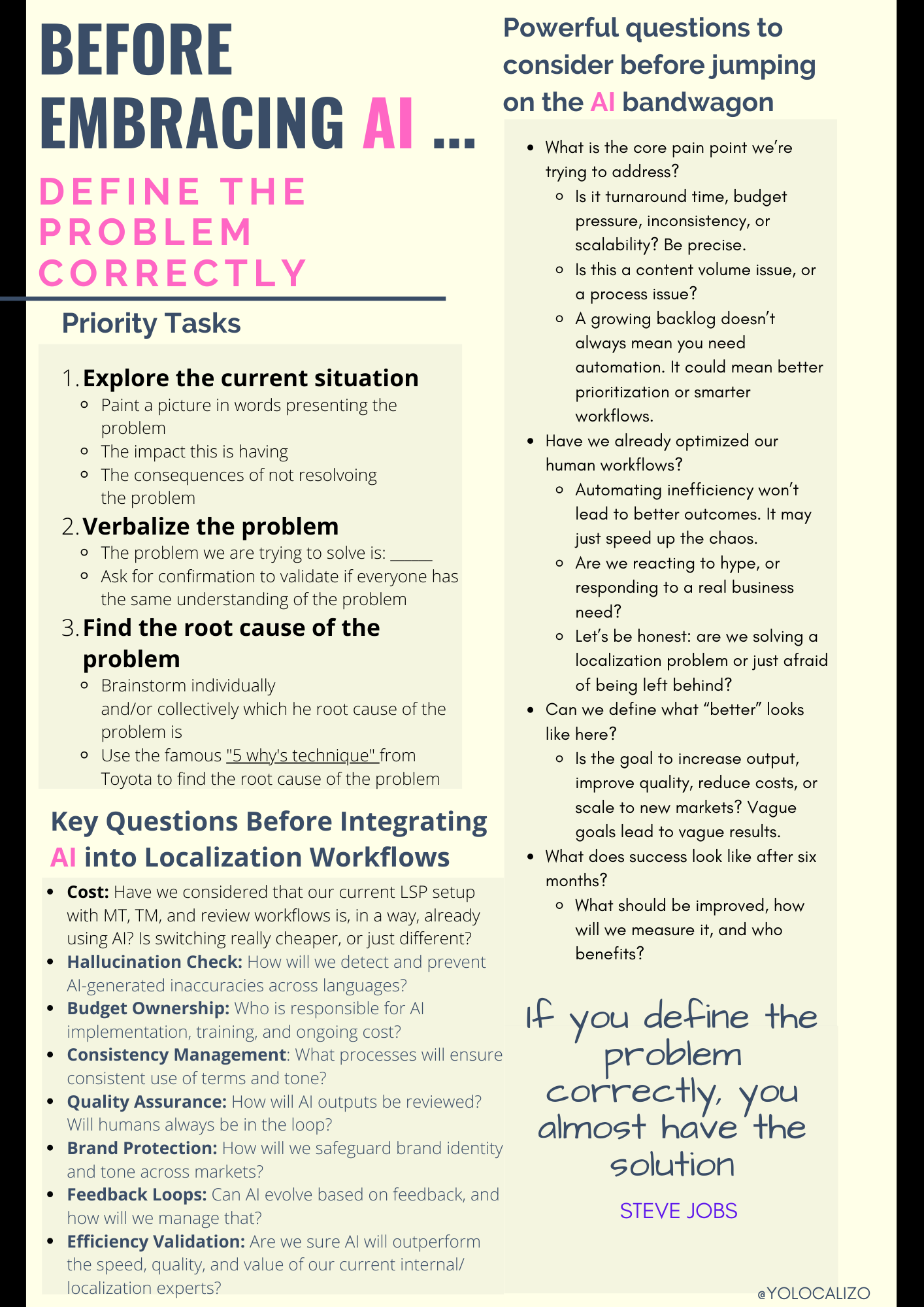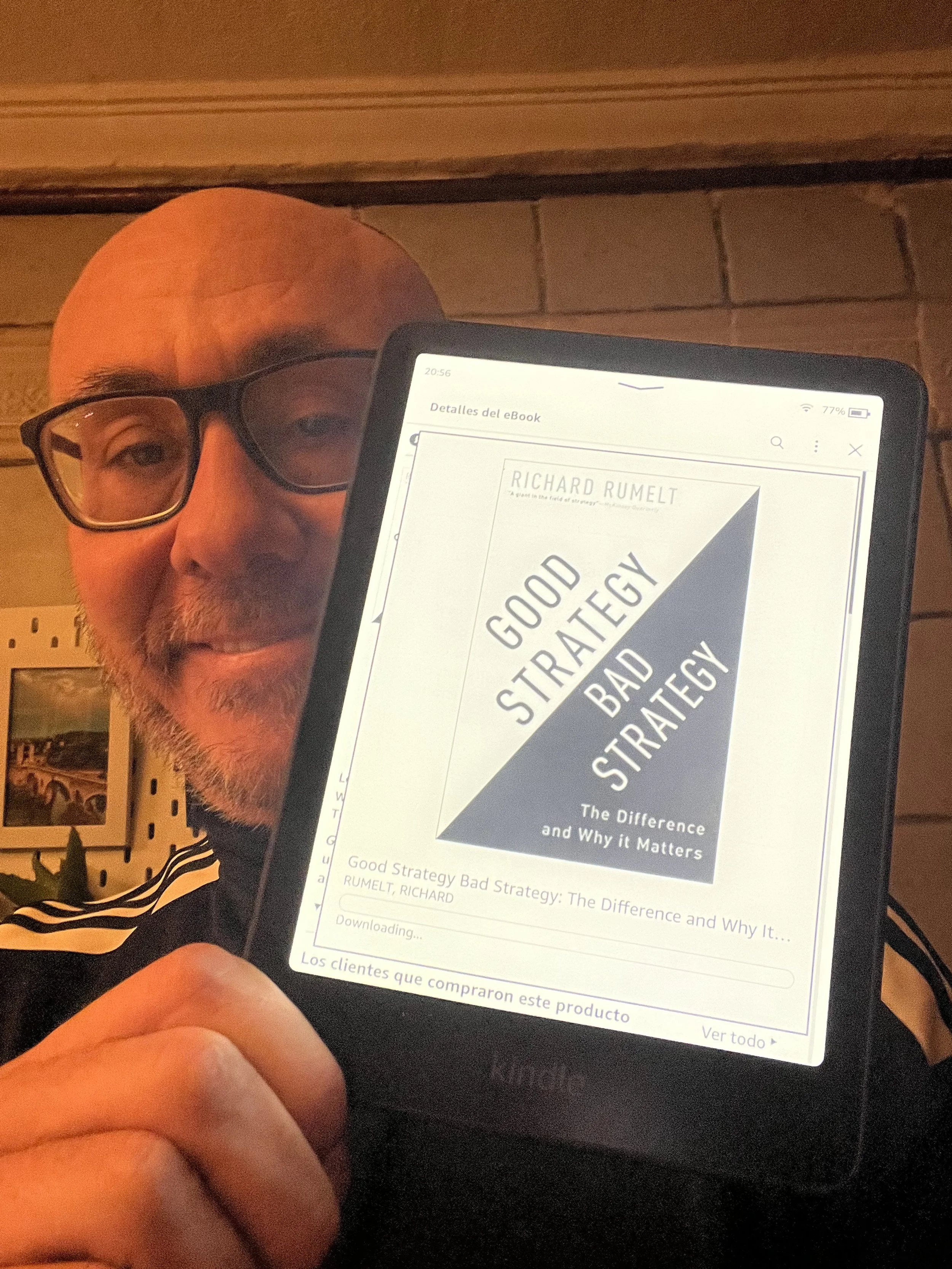What Makes a Strategy Good? My book review of the lessons from Richard Rumelt’s classic
I like reading. The idea that most of the problems we want to solve might already have been written about fascinates me. I usually read more business-related books than fiction. For fiction, I prefer TV shows (by the way, Only Murders in the Building, the series I watched during my Christmas holidays, is fantastic. I highly recommend it; the intelligent humor and the vibe between the main trio are great).
In an ideal world, I’d always read on paper. Books still feel magical to me, the smell of a book, the feeling of turning pages. Spending all day in front of a computer also makes books a welcome escape from screens. But the reality is that I read eBooks. Ultimately, they’re so convenient: they take up less space at home, eBooks are usually cheaper than traditional paper books, and you can read in bed without disturbing anyone thanks to the backlit screen. For those of us who read in another language, they’re also fantastic because they help us learn new words. Plus, searching for text or highlighted sections in an eBook is way more practical than in a traditional book.
I’ve been reading on my Kindle for quite a while. I think I bought my current Kindle back in 2015 or 2016, and although it still works fine, I was thrilled when the Three Kings brought me the new Kindle Paperwhite! As you can imagine, with how fast technology evolves, a digital product that’s 10 years newer than my current device is a big upgrade. So, feeling like a kid with a new toy, I unboxed it with all the excitement that gift day deserves. I set it up and immediately read a book I’d had on my radar for a while: Good Strategy, Bad Strategy.
My old Kindle, soooo many books and hours of joy it gave me in the last decase …
In the next few paragraphs, I’ll share the most important ideas from the book and how we can apply them to our work as localization professionals.
Why I Decided to Read This Book
The title caught my attention, and the excerpt on the cover and first pages reminded me of a question I often ask myself: Why are there so many books about strategy? If you go on Amazon, you’ll literally find thousands of books in categories like Strategic Management and Business Strategy/Management. The sheer volume of literature on this topic is incredible. Another thing that piqued my interest was finding a way to spot when a strategy is just fluff or wishful thinking. This book promised tips to help us distinguish between good strategy and bad strategy. Does it deliver? Keep reading, and I’ll tell you everything!
The Author
Richard P. Rumelt, author of Good Strategy/Bad Strategy: The Difference and Why It Matters, is a renowned professor and consultant in the field of strategy. As a professor at UCLA Anderson School of Management, Rumelt has advised leading corporations and governments around the globe, blending exceptional academic rigor with outstanding practical expertise. His work has reshaped how leaders and organizations tackle strategic challenges and seize opportunities.
With countless management books available, what sets this one apart and makes it truly worth reading?
Good Strategy/Bad Strategy stands out because it cuts through the fluff, offering a clear, actionable framework for creating real impact. Richard P. Rumelt focuses on diagnosing challenges, crafting guiding policies, and aligning actions, while exposing the pitfalls of vague, ineffective strategies. With real-world examples and sharp insights, it redefines strategy as problem-solving
The book in 3 sentences
Good Strategy/Bad Strategy shows what separates real strategy from empty buzzwords, teaching us how to solve critical problems with focus, clear direction, and actionable steps. With sharp insights and real-world examples, it’s a masterclass in creating strategies that truly deliver results.
Book summary, something longer than 3 sentences!
Strategy can often feel like a vague or overused concept, but it’s crucial for achieving real results. In Good Strategy/Bad Strategy, Richard Rumelt breaks it down to its essentials: solving real challenges with focus and clear actions. He highlights three key ideas that set good strategies apart: understanding the core problem, focusing resources on what matters most, and avoiding the common traps of vague goals or poorly planned approaches. These principles provide a powerful framework for tackling complex challenges effectively.
Let’s see these ideas one by one and apply them to our localization industry






Idea number 1
1. The Kernel of Good Strategy
At the heart of a good strategy lies what Richard Rumelt calls the "kernel," a simple yet powerful framework with three essential elements:
Diagnosis: Understand and Clearly Define the Core Challenge
Diagnosis is the foundation of any effective strategy. It’s about identifying the root cause of the problem or the critical challenge that must be addressed. Without a clear understanding of what you’re solving, efforts will be scattered, and solutions will often miss the mark. A good diagnosis simplifies complexity, focusing attention on what truly matters. It goes beyond surface symptoms to pinpoint the underlying issues, setting the stage for a meaningful response. For example, diagnosing “falling sales” is too broad. A better diagnosis might reveal that the real issue is outdated product offerings or a misaligned marketing approach.
Guiding Policy: A Coherent Approach to Tackle the Challenge
Once the challenge is diagnosed, the guiding policy provides a clear direction on how to address it. This is the overarching approach that frames decision-making and prioritizes efforts. A good guiding policy is neither a detailed plan nor a vague vision, it’s a logical, actionable response to the diagnosis that channels resources and actions effectively. For instance, if the diagnosis identifies a lack of customer trust, a guiding policy might focus on rebuilding reputation through transparency and improved service. It acts as a signpost, ensuring efforts are coordinated and aligned toward a shared objective.
Coherent Actions: Align Efforts and Resources to Achieve Results
Coherent actions are the specific steps and initiatives taken to implement the guiding policy. These actions must work together, reinforcing one another to create a cumulative effect. A scattershot or conflicting set of actions can derail even the best diagnosis and guiding policy. For example, if the guiding policy involves focusing on premium customers, coherent actions might include tailoring marketing to this segment, adjusting product design to match their preferences, and training staff to provide a higher level of service. Coherence ensures that every part of the strategy pulls in the same direction, maximizing impact.
Together, these three elements form a tightly integrated kernel that turns abstract goals into focused, effective action. They also serve as a checkpoint: if any of these components are missing or weak, the strategy is likely to falter. Organizations can clarify their challenges, align their efforts, and make meaningful progress when applying this framework.
Checklist: Do You Have the Kernel of Good Strategy?
1. Diagnosis: Defining the Core Challenge
✔ Have you clearly identified the root problem or obstacle?
✔ Does your diagnosis simplify complexity and focus on critical issues?2. Guiding Policy: Crafting a Coherent Approach
✔ Does your guiding policy provide clear direction for addressing the diagnosis?
✔ Does it eliminate distractions and focus resources effectively?3. Coherent Actions: Aligning Efforts
✔ Are your actions logically tied to the guiding policy?
✔ Do the actions reinforce each other and address the core challenge?
Applying this to a Localization scenario
I’ve lost count of how many times I’ve heard “translation quality issue” being identified as the problem to solve when, in many cases, that’s not actually true. This is what the book's author calls shallow analysis, jumping straight to the solution without adequately analyzing the problem itself. If we base our strategy entirely on the “translation quality issue,” we might fall into what’s defined as a bad strategy (more on that in the next paragraph).
There’s a different way to approach it, and that’s by applying the concept of the kernel that we’re discussing. Let’s tackle this scenario by using the kernel framework to create a localization strategy for a specific case.
Applying the Kernel of Good Strategy to Localization
Let’s explore how the three elements of the strategy kernel diagnosis, guiding policy, and coherent actions can apply to localization challenges:
2. The Pitfalls of Bad Strategy
Bad strategy is surprisingly common and often hides behind ambitious goals, motivational language, or grandiose visions. While it may sound inspiring, bad strategy fails to address real challenges or guide meaningful action. Richard Rumelt identifies several key traits that define bad strategy and explains why they lead to failure.
Key Pitfalls of Bad Strategy
Four signs indicate that we might be dealing with a bad strategy. In the next section, we will go through them one by one.
· Lack of a Clear Diagnosis
Bad strategy often skips the hard work of analyzing and identifying the core challenge. Instead, it jumps straight to vague objectives (or a laundry list of tasks). Without a diagnosis, efforts are misdirected, and solutions fail to address the real problem.
· Substituting Goals for Strategy
Ambitious goals are not strategies. Saying, "We want to become the market leader" or "We aim to grow revenue by 20%" provides no guidance on how to achieve these outcomes. A strategy explains how to overcome obstacles and achieve results, not just the end goal.
· Spreading Resources Too Thin
Trying to do too much at once leads to diluted impact and wasted effort. Organizations pursuing too many initiatives often fail to make progress on their most important objectives. Strategy requires prioritization and focus, not the pursuit of every opportunity.
· Fluff and Wishful Thinking
Bad strategy often relies on buzzwords, slogans, or feel-good phrases that sound impressive but lack substance. For example, saying, "We will achieve excellence through innovation and synergy," provides no concrete direction or actionable steps. Fluff replaces the clarity and specificity needed for effective action.
How to Avoid Bad Strategy
Start with Diagnosis: Define the core problem or obstacle you need to overcome.
Focus on the How: Avoid setting vague goals and instead craft a guiding policy that explains how to achieve success.
Concentrate Resources: Prioritize the most critical initiatives and say no to distractions.
Cut the Fluff: Replace buzzwords with clear, actionable plans tied to measurable outcomes.
Applying the Pitfalls of Bad Strategy to Localization
How to Avoid These Pitfalls
Start with Diagnosis: Identify key challenges in localization. For example, “Our team lacks expertise in cultural adaptation for Asian markets,” or “We don’t have enough resources to localize for all 15 languages.”
Focus on the How: Develop a guiding policy, such as “Prioritize localization for the top five markets with the highest revenue potential while improving workflows for future scalability.”
Concentrate Resources: Focus efforts on a smaller number of high-impact markets, such as Europe or South America, before scaling to others. Allocate budgets and expert resources where they matter most.
Cut the Fluff: Replace vague ambitions with specific, measurable plans. For example, “By the end of Q3, launch localized content for Spanish, German, and French markets with 95% accuracy and culturally adapted marketing campaigns.”
More examples of the book
The book is packed with examples, plenty of them. At times, it felt overwhelming to get through so many pages, and while it’s certainly well-documented, it can get a bit repetitive. Still, summarizing the good and bad strategy examples scattered throughout the book seems like an interesting addition to this post. So, let’s dive into the list
Best Examples of Good Strategy from the Book
Steve Jobs’ Turnaround of Apple (1997)
Diagnosis: Apple was unfocused with a bloated product line.
Guiding Policy: Simplify and focus on core products.
Coherent Actions: Cut product lines, outsource manufacturing, and secure funding from Microsoft. This set Apple on a path to success with innovations like the iPod.
General Schwarzkopf’s Desert Storm Strategy (1991)
Diagnosis: A direct assault on entrenched Iraqi forces would be costly.
Guiding Policy: Use overwhelming force and outflank Iraqi defenses.
Coherent Actions: Conducted a deceptive air campaign, shifted forces west for a surprise flank attack, and coordinated across all military branches.
Nvidia’s Rise in Graphics Processing (1999–2007)
Diagnosis: Gamers demanded faster 3-D graphics, and competitors were slow to innovate.
Guiding Policy: Outpace competitors with faster chip development cycles.
Coherent Actions: Created overlapping development teams, invested in advanced tools, and unified driver architecture, securing Nvidia’s market dominance.
Best Examples of Bad Strategy from the Book
Lehman Brothers’ Risky Growth Strategy (2006)
Diagnosis: Failed to recognize the growing instability in the housing market.
Guiding Policy: “Grow faster than the industry” by increasing risk appetite.
Actions: Took on high-risk deals rejected by competitors without proper risk mitigation. This lack of clear diagnosis and reckless actions led to the firm’s collapse in 2008, triggering a global financial crisis.
U.S. National Security Strategy (2006)
Diagnosis: No clear definition of the core challenges, such as how to address nuclear proliferation or regional conflicts.
Guiding Policy: Ambitious goals like “prevent enemies from threatening us with WMDs,” without actionable plans.
Actions: Substituted vague slogans for strategies, leading to a lack of coordinated or effective actions in key areas like intelligence and global security.
Los Angeles Unified School District’s Improvement Plan (2006)
Diagnosis: Blamed underperformance on vague issues like weak leadership without addressing systemic problems like poverty or teacher quality.
Guiding Policy: Set unrealistic goals such as creating “transformational leaders” in struggling schools.
Actions: Proposed ineffective measures like creating new training programs and requiring meetings, which did little to address the root causes of failure.
Closing
The book is very good, though a bit long for my taste. Some ideas are repeated over and over, with the author referencing them again and again. While I understand the importance of repetition to help solidify concepts in our minds, I did find the style somewhat repetitive at times. That said, credit where it’s due: the book, though occasionally monotonous, contains buried ideas that are incredibly useful.
I hope you enjoyed reading my summary, and happy 2025 ofc!
@yolocalizo












As a Globalization/Localization Manager to be effective and rise to the various challenges our teams encounter we must be fundamentally flexible. We must be able to have the right conversation with the different stakeholders we interact with. We must understand the unique ways in which each conversation should be handled.
To achieve our goals, we need to bring 5 different conversations into the workplace